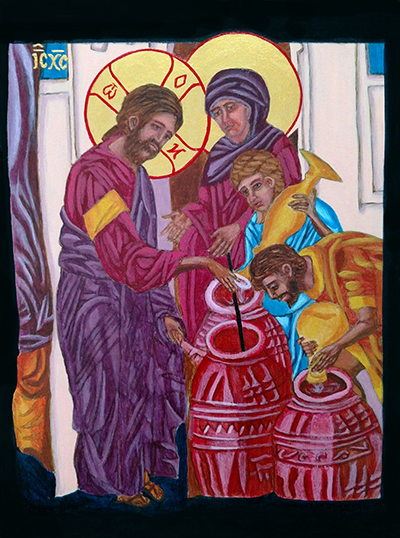What is an Icon?

An icon (from Greek εἰκών eikōn "image") is a religious work of art from Eastern Orthodox Christianity and Catholicism. Originating in the earliest days of the Church, icons were a means of peaching the Good News to those who could not read nor have access to the early manuscripts and scrolls of the Judaic Scriptures and writings of the Apostles and early Church Fathers.
For the iconographer, an icon is first and foremost a prayer in service to God and the preaching of His Good News. It is an invitation to the humility to accept oneself and abandon oneself to the spiritual journey of seeking to become the paintbrush in God's hand as He writes the icon through the iconographer.
For those viewing the icon, it is an invitation to glimpse into heaven and see things as God sees things. Rendered in a very stylistic and structured way, these windows into heaven seek to portray things from God's perspective. "For my thoughts are not your thoughts, nor are your ways my ways—oracle of the Lord. For as the heavens are higher than the earth, so are my ways higher than your ways, my thoughts higher than your thoughts." (Isaiah 55:8-9) Icons are also an invitation to prayer contemplating God's love for us.
Icons have their own canon for the use of color. Color is symbolic and certain hues are reserved for specific persons. Because we do not see as God sees, perspective in an icon is often reversed, and distortion beyond the physical capabilities often seems strange to human eyes. Figures sometimes have have a translucent, almost transparent quality. And there are no shadows, since in writing an icon, the iconographer goes from darker hues to lighter ones. The work is highlighted to signify that God is Light, and as we approach God, we move from darkness to Light, the internal source of God within each subject.
There are presently three "classic" styles of icons: Greek, which uses primary colors and emphasizes Greco-Roman facial features; Russian with more vibrant colors and more elongated figures; and Coptic, which is more simple, almost cartoonish. The current trend is toward a more modern style. My icons tend to be more Russian/Modern.
A Bit of History
Icons can be found in the Catacombs and tradition holds that St. Luke was an iconographer who used them in his preaching. In the early Church a controversy arose between iconoclasts (who cited the first commandment prohibition of the making and worship of idols) and iconodules (who used them as a source of prayer). The second Council of Niceae (787 A.D.) addressed the issue stating that since no man has seen God, icons could not represent the unseeable and unknowable. However, since Jesus, who had walked on earth as a man, was both seeable and knowable, icons could represent Jesus and the saints. The Council also made the distinction that icons were venerated as sacred objects, much as the Chalice or the Altar at Mass are venerated, putting an end to the question of idol worship.
Concerning the charge of idolatry: Icons are not idols but symbols, therefore when an Orthodox venerates an icon, he is not guilty of idolatry. He is not worshipping the symbol, but merely venerating it. Such veneration is not directed toward wood, or paint or stone, but towards the person depicted. Therefore relative honor is shown to material objects, but worship is due to God alone.
We do not make obeisance to the nature of wood, but we revere and do obeisance to Him who was crucified on the Cross... When the two beams of the Cross are joined together I adore the figure because of Christ who was crucified on the Cross, but if the beams are separated, I throw them away and burn them. —St. John of Damascus
The Decision of the Council
Concerning the teaching of icons
Venerating icons, having them in churches and homes, is what the Church teaches. They are "open books to remind us of God." Those who lack the time or learning to study theology need only to enter a church to see the mysteries of the Christian religion unfolded before them.
They proclaimed: Icons... are to be kept in churches and honored with the same relative veneration as is shown to other material symbols, such as the 'precious and life-giving Cross' and the Book of the Gospels. The 'doctrine of icons' is tied to the Orthodox teaching that all of God's creation is to be redeemed and glorified, both spiritual and material.
Concerning the doctrinal significance of icons
Icons are necessary and essential because they protect the full and proper doctrine of the Incarnation. While God cannot be represented in His eternal nature ("...no man has seen God", John 1:18), He can be depicted simply because He "became human and took flesh." Of Him who took a material body, material images can be made. In so taking a material body, God proved that matter can be redeemed. He deified matter, making it spirit-bearing, and so if flesh can be a medium for the Spirit, so can wood or paint, although in a different fashion.
I do not worship matter, but the Creator of matter, who for my sake became material and deigned to dwell in matter, who through matter effected my salvation... —St. John of Damascus
